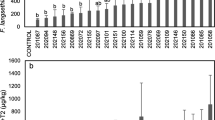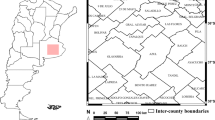Abstract
Thefusarium mycotoxins deoxynivalenol (DON) and zearalenone (ZON) were determined in conventionally and organically grown grain harvested 1998 in Thuringia/Germany. A total of 196 wheat samples and 69 rye samples was analysed.
In this year with heavy rainfalls during the summer months, high concentrations offusarium mycotoxins were typical in grain grown in Germany, as the DON concentrations found here. DON concentrations in conventionally grown wheat were found to be significantly higher than in organically grown wheat. 69% of the conventionally grown wheat were tested positive, containing a mean concentration of 1540 µg/kg DM. In 54% of the organically grown wheat samples DON was detected with a mean value of 760 µg/kg DM. DON concentration in rye and ZON concentration in wheat showed similar tendencies.
The different cultivars of conventionally grown wheat showed large differences in DON contamination.
Zusammenfassung
DieFusarientoxine Deoxynivalenol (DON) und Zearalenon (ZON) wurden in konventionell und ökologisch angebautem Getreide der Ernte 1998 aus Thüringen/Deutschland untersucht. Insgesamt wurden 196 Weizen und 69 Roggenproben analysiert. Im Ertejahr 1998, einem Jahr mit starken Niederschlägen in den Sommermonaten, waren hohe Fusarientoxinbelastungen, wie die hier gefundenen DON- Konzentrationen, in deutschem Getreide üblich.
Der Weizen aus konventionellem Anbau war signifikant höher mit DON belastet als der aus ökologischem Anbau. 69% des konventionell angebauten Weizens waren positiv, mit einem mittleren Gehalt von 1540 µg/kg T. In 54% des ökologisch angebauten Weizens wurde DON mit einer mittleren Konzentration von 760 µg/kg T nachgewiesen. Die DON Konzentrationen im Roggen und die ZON Konzentrationen im Weizen zeigten ähnliche Tendenzen.
Die verschiedenen Sorten des konventionell angebauten Weizens zeigten deutliche Unterschiede in den ermittelten DON Konzentrationen.
Similar content being viewed by others
References
Marx H, Gedek B, Kollarczik B (1995) Vergleichende Untersuchungen zum mykotoxikologischen Status von ökologisch und konventionell angebautem Getreide. Lebensm. Unters. Forsch. 201: 83–86
Stähle A, Birzele B, Schütze A, Krämer J, Dehne H-W (1998) Optimierungsstrategieen im Organischen Landbau: Auftreten von Fusarium spp. und DON-Konzentrationen in Winterweizen aus Organischem Landbau im Jahr 1997. Proc., 20. Mycotoxinworkshop, Detmold, 08.–10.06.1998, pp.262–266
Valenta H, Oldenburg E (1995) Bestimmung von Zearalenon, α-Zearalenol und β-Zearalenol in Maissilage mit HPLC und GC/MS. 107. VDLUFA-Kongreß, Garmisch-Partenkirchen, 09.1995, VDLUFA-Schriftreihe 40/1995, pp.957–960
Thuringian Institute of Agriculture (1999) unpublished results
Author information
Authors and Affiliations
Rights and permissions
About this article
Cite this article
Döll, S., Valenta, H., Kirchheim, U. et al. Fusarium mycotoxins in conventionally and organically grown grain from Thuringia/Germany. Mycotox Res 16 (Suppl 1), 38–41 (2000). https://doi.org/10.1007/BF02942977
Issue Date:
DOI: https://doi.org/10.1007/BF02942977




